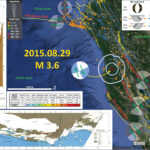An earthquake occured this morning in Compton! Initially a 3.2, is currently a M = 2.9, as reported by the USGS (here is their web page). Here is a map that shows the faults, the earthquakes from the past decade,…
Earthquake between the San Andreas and Maacama!
Saturday morning (2015.08.29), residents in Fort Bragg were awakened by a M 3.6 earthquake along a fault that lies between the San Andreas fault (SAF) to the west and the Maacama fault (MF) to the east. Here is the USGS…
Earthquake near the Santa Cruz Islands (western Pacific)!
Yesterday we had a large magnitude earthquake along a plate boundary that connects the South Solomon trench with the New Hebrides trench. This region had a swarm of earthquakes in May. Here is the USGS website for the M 6.6…
Solomon Islands Earthquake!
Today we had another earthquake in this tectonically active region of the world. Initially posted as a magnitude 7.0, the USGS considers this a M = 6.6 earthquake. Here is a map showing the epicenter as an orange circle. I…



